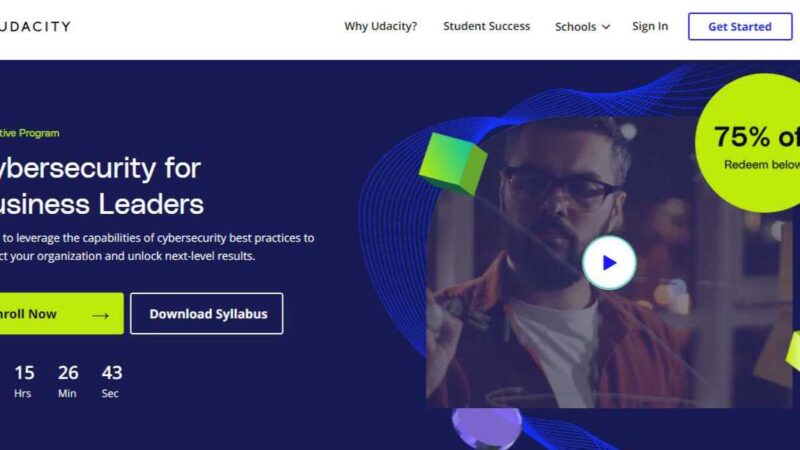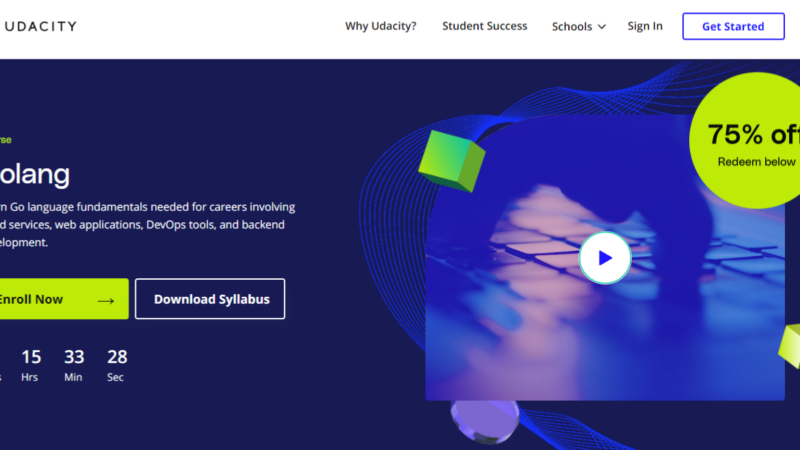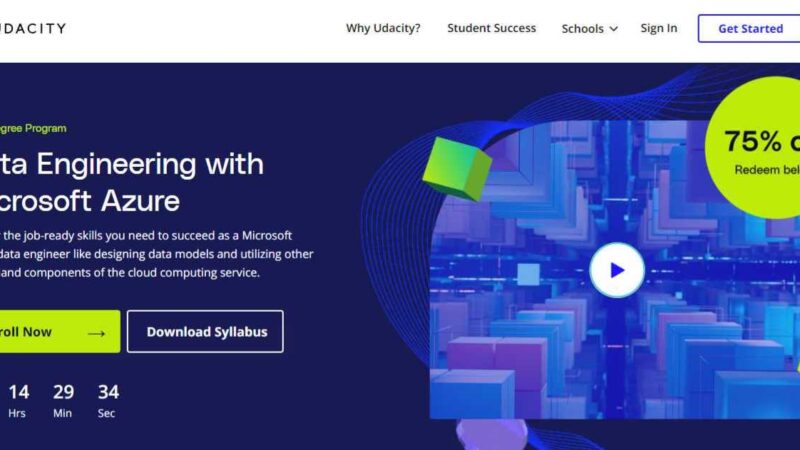Udacity Intro to Machine Learning with PyTorch Nanodegree Review

Machine learning is growing fast and spreading into a large number of markets. The more advanced that our technology gets, the more of a demand there is for algorithms that can power them. That is why Artificial Intelligence and Machine Learning are both hot careers that are on the rise and will continue to be as the industry advances.
If it sounds like a dream, you could make it happen faster than you think with help from the Intro to Machine Learning with PyTorch Nanodegree from Udacity. This program was made in collaboration with industry-leading companies Kaggle and AWS and comes packed with hands-on experience to apply your newly learned knowledge. The fascinating world of AI and IT can be right at your fingertips, faster than you could possibly imagine.
About Udacity
Before we get to the course, let’s look at Udacity. Udacity is an online academy that focuses on IT courses. You can find free lessons and tutorials and, paid programs known as nanodegrees. These nanodegrees are Udacity’s start products, developed in collaboration with IT companies and packed with hands-on projects that allow learners to apply. Udacity has been in the teaching game for more than a decade, putting out a long list of knowledgeable learners that are ready to break into the world of IT.
What’s a Nanodegree?
The star product from Udacity is their nanodegree. This is a certification course that focuses on one specific area within the world of IT. Using video lectures and examples, instructors will lead learners along the way, giving them enough knowledge to apply to the hands-on projects found within each nanodegree course. Most nanodegrees from Udacity are made in collaboration with top names in the industry, coming with real-industry issues to solve along the way. Included with each Udacity nanodegree is:
- Your technical mentor
- A community of learners to connect with from day one
- Hands-on real industry issues to solve
- A database with recruiters from some of today’s hottest companies
- Career services including a mock interview and resume cleanup
- A-list instructors with both teaching and industry experience
Meet your Instructors
Udacity goes out of their way to find the best of the best when it comes to instructors. Most of them have experience teaching and working in the field, able to give a unique perspective along with real industry examples and advice to push learners in the right direction. For the Intro to Machine Learning with PyTorch Nanodegree, your instructors include:
Cezanne Camacho
Cezanne is your curriculum lead and an expert in the field of machine learning. Her education took place at Stanford University where she received her masters in Electrical Engineering. Her industry experience was mostly in the medical field, where she applied machine learning techniques to medical diagnostic equipment and applications.
Mat Leonard
Mat is a physicist by education-working in the field of neuroscience. His approach to the field of machine learning and his knowledge with advanced techniques and scientific practices gives him a different perspective and approach that learners will be happy to have.
Luis Serrano
Luis was a Machine Learning Engineer at Google in his early profession. His time in the industry working for one of the top companies. His experience in the field along with his expertise in mathematics adds to his unique approach to teaching learners throughout the Machine Learning with PyTorch course.
Jennifer Staab
Jennifer works mostly with Biostatistics. During her time in the field, she has worked as a professor for the Florida Polytechnic University and with United Therapeutics as a computer scientist. She has both teaching experience and a great view of what the industry is like, passing on her knowledge down to students in each lecture.
Sean Carrell
Sean is an expert mathematician. He is a specialist in Algebraic Combinatorics, using his knowledge to power some of the most advanced machines you’ll work with in the program.
Josh Bernhard
Josh is a Data Science instructor. During his career, he has led lectures with Galvanize and has worked as a Data Scientist himself at Nerd Wallet. His experience ranges from cancer research to process automation, making his lessons super engaging and interesting with all of his expertise.
Jay Alammar
Jay has a bit of a different set of knowledge when it comes to teaching. He takes a look at the business side, as he has focused his time in his career on high-technology startups. He’ll talk about the demand including jobs and salaries that you can expect when you get your foot in the door.
Course Breakdown
Prerequisites
When you step into the course, Udacity expects you to have experience with Python programming at an intermediate level. This means that you have seen and worked with data structures, dictionaries, and lists. Also, you’ll need to have a good grasp of other Python languages like NumPy and pandas. In addition, you’ll need a good basis of statistics, including the ability to calculate and understand probabilities and distributions.
Supervised Learning
In the first lesson, you’re introduced to supervised learning. This is one of the most common methods when it comes to model constructions, the very basis of what you’ll build more complex machines on.
- Project! CharityML Donors
CharityML is a mock charity created by Udacity. The goal is to take a look at different algorithms, seeing how you can tweak everything to find the highest donation yield. You will get to use algorithms and gain some hands-on experience from the very first section and beyond.
Dive into Deep Learning
In this section, you’ll start to take your knowledge base a little deeper. This is all about neural network design and how it helps all the pieces of the puzzle come together. You’ll be using PyTorch in this section, getting to dive deeper into the languages and techniques used to create advanced learning machines.
- Project! Building an Image Classifier
Work with a deep learning model to create an image classification system. You will work with a dataset of images, using the application to train and classify new images. In this section, you’ll use Jupyter Notebook, taking it from there into a Python-compatible application that can run in smoothly in your system.
Unsupervised Learning
Problematic domains are not all that uncommon. In this section, you’ll work with them to see how to use unsupervised learning to solve problems and create commands that will execute a system of workflows.
- Project! Create Customer Segments
Taking what you learned in all sections and building it up, you’ll develop a way to bring forth similarities in customers within a list. Work with clustering techniques to simplify methods and reveal useful information that marketing and production teams can work with.
How Long Does the Course Take?
Though it may sound like a lot to get to, you can actually finish a lot faster than you might think. Udacity estimates that the course will take three months if learners are dedicating about 10 hours per week. With the self-paced learning perk that comes with all Udacity nanodegrees, you could extend that, just as long as you keep up with project deadlines. While you might be thinking this is a sweet deal and want to slack off a bit, you’ll need to think twice, especially because of the price.
How Much Does the Course Cost?
Udacity offers two ways to pay. Both of them are great but, they just depend on how long you think you will take to complete the program. You can pay month to month, taking as long as you like as long as you keep up with deadlines for the end of section projects. Doing it this way, you’re looking at $359 per month. If you take Udacity’s suggestion, you’re looking at a one-time payment, with a 15% discount added in, bringing the total to $927. In this way, you will need to complete the course in three months, going with Udacity’s suggestion.
Both are great ways to pay and each has its benefits. To decide, it is best to take a look at your schedule, looking at how much time you have to dedicate to the program. If you think you can finish in less than three months, you can save a bit plus, get your foot in the door faster. If not, paying one payment with a discounted price is the best way to go, taking your time and learning without any stress.
What Have Learners Said?
The Machine Learning with PyTorch Nanodegree from Udacity has an overall positive rating online. Out of the students that have taken the time to write about their experience, the course has a 4.7 out of 5-star rating, and here is what a few of them had to say.
“The schedule is aggressive. There is a lot of math to consume and apply. I don’t see how others move so quickly unless they skip the math. The math/concept is the most important part of the lessons. For me every nano degree that I take will take me longer b/c I believe that I really need to have a solid understanding of the applied concepts. This will become expensive. There should be more options than just adding another $400 month segment.” – Kim S
“This course has served as a great intro into machine learning. Just enough background knowledge to have a reasonable understanding of the intuitions that inform key ML algorithms and the technical considerations that go into using machine learning in practice. Of course, there are whole books on things like feature selection/extraction, but this course gives you enough to get started and most importantly the confidence to dig deeper as desired.” – Shomari M.
“It is all going great! I am surprised by how good lessons and practice are, the right mix of math and formalism with a more intuitive approach, I really feel like I am learning and I will definitely consider more nanodegrees in the future! Especially if I can get a job with this one that would allow me to be able to afford to enroll for more in the future.” – Dario D.
How’s the Job Market?
Machine learning is on the rise and becoming more in demand by the day. As technology and programming languages advance, so too do the possibilities of advanced machine learning objects. Artificial intelligence is said to be one of the most in-demand jobs from now and beyond, growing year after year. A recent analysis showed that there were 2.3 million jobs created just this year. The industry is booming with products that are powered by machine learning, said to be worth $8.8 billion in the year 2020 alone. This number is only expected to rise, as technologies and methods continue to advance.
Final Thoughts…
Machine Learning is interesting. The more advanced that the technologies used in the creation of today’s gadgets get, the more in-demand knowledgeable machine learning experts become. The ability to work with Python to construct data structures and modeling constructions is a huge skill, one that large companies in the industry are on the hunt for. To gain the knowledge necessary to break into the field, you’ll have to learn somewhere, taking your pick at either online or on-site classes.
With a nanodegree from Udacity, you can take as much time as you want to finish the course. Learn the techniques that real machine learning experts use, applying them to the projects that were created in collaboration with Kaggle and AWS. You’ll leave this course with hands-on experience plus, be able to interview with confidence with help from career services. Breaking into the industry is not difficult and can be done faster than you think with help from a Udacity nanodegree. To enjoy a bit of a discount and get the best deal, buckle up and get through the course, saving time and money to break into the field faster than you could have imagined.





